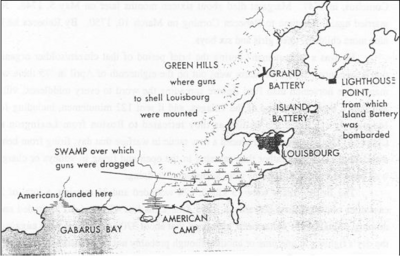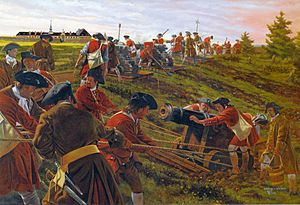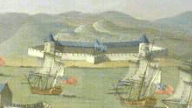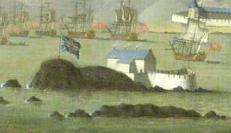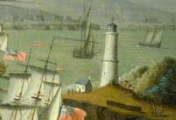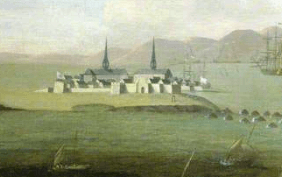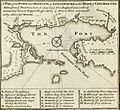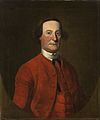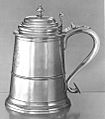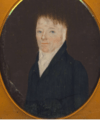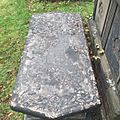Siege of Louisbourg (1745) facts for kids
Quick facts for kids Siege of Louisbourg |
|||||||
|---|---|---|---|---|---|---|---|
| Part of the War of the Austrian Succession | |||||||
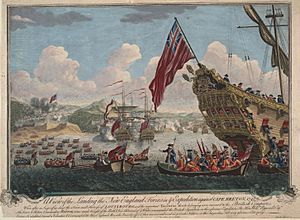 The landing of troops from New England on the island of Cape Breton to attack Louisbourg, Unknown author |
|||||||
|
|||||||
| Belligerents | |||||||
| Commanders and leaders | |||||||
| Strength | |||||||
| 4,200 90 warships and transport ships |
2,390 | ||||||
| Casualties and losses | |||||||
| 100 killed and wounded 900 dead of disease |
130 killed and wounded 300 dead of disease 1,400 captured |
||||||
The Siege of Louisbourg in 1745 was a big battle during the War of the Austrian Succession. This war was also known as King George's War in the British colonies. During the siege, a group of soldiers from New England worked with the British navy. Together, they captured Louisbourg. This city was the main city of the French area called Île-Royale (which is now Cape Breton Island).
The British colonies in the north saw Louisbourg as a threat. They called it the "American Dunkirk" because French privateers used it as a base. Privateers were like legal pirates who attacked enemy ships. There were often small wars between the French and their allies, the Wabanaki Confederacy, and the New England colonies.
For the French, the Fortress of Louisbourg was very important. It protected the main way into Canada and the nearby French fishing areas. The French government had spent 25 years building its defenses. It cost a lot of money, about thirty million livres.
Even though the fortress had strong defenses facing the sea, it had a weak spot. There were low hills behind it that made it easy to attack from land. Attackers could set up their cannons on these hills. The soldiers defending the fort were not paid well or given enough supplies. Their leaders also did not trust them. The attackers from the colonies were also new to fighting. But they managed to take control of the areas around the fort. The French soldiers gave up when the attack was about to happen.
Louisbourg was a key part of the peace talks to end the war. It was a major British success. Some British leaders did not want to give it back to the French. But in the end, Louisbourg was returned to French control. This happened after the 1748 Treaty of Aix-la-Chapelle. The British colonists who had won the battle were not happy about this.
Contents
Why Was Louisbourg Important?
For many years, there had been fights between the French and their allies, and the English in the area. The Treaty of Utrecht ended an earlier war. It gave the French colony of Acadia to Great Britain. The Wabanaki Confederacy tribes had often raided British settlements in Northern New England. Many British military leaders in the Louisbourg siege came from this area. Their families had been hurt in these raids.
In 1744, people in New England worried about more attacks. A French and Wabanaki group sailed from Louisbourg to Canso, a British fishing port. They attacked a small fort on Grassy Island and burned it. They took 50 British families as prisoners. This port was important for New England fishing boats.
The prisoners from Canso were first taken to Louisbourg. They were allowed to move around freely. Some of the soldiers carefully studied the fortress. They looked at its design, how it was laid out, and its condition. They also noted the number of soldiers and cannons. These men were later sent to Boston. Their information, along with details from merchants who traded in Louisbourg, helped plan the attack.
What Problems Did the French Face?
The French soldiers and people in Louisbourg were not doing well. Supplies were low in 1744. Fishermen did not want to sail without enough food. The soldiers said they were promised a share of the goods from the Canso raid. But the officers took everything and sold it for their own profit.
In December 1744, the soldiers rebelled. They were upset about the bad conditions and not being paid for months. The acting governor, Louis Du Pont Du Chambon, calmed them down by giving them back pay and supplies. But the winter was still very tense. The military leaders barely kept control. Duchambon was even afraid to ask for help. He worried his message would be stopped and cause more trouble. But news of the problems still reached Boston.
How Did the Attack Begin?
In 1745, William Shirley, the governor of Massachusetts, got support for an attack on the fortress. It was a very close vote in the Massachusetts government. He and Benning Wentworth, the governor of New Hampshire, asked other colonies for help.
- Connecticut sent 500 soldiers.
- New Hampshire sent 450 soldiers.
- Rhode Island gave a ship.
- New York provided ten cannons.
- Pennsylvania and New Jersey sent money.
William Pepperrell from Kittery (part of Massachusetts then) led the land forces. Captain Edward Tyng commanded a fleet of colonial ships. Governor Shirley asked Commodore Peter Warren, a top officer in the Royal Navy in the West Indies, for naval help. Warren's ships were much stronger than the colonial ones.
Warren first said no because he did not have orders from London. But a few days later, he got orders to protect the New England fishing areas. The expedition left Boston in stages starting in early March 1745. It had 4,200 soldiers and sailors on 90 ships.
The Battle for Louisbourg
Stopping at Canso and Port Toulouse
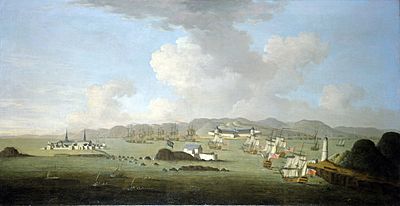
The forces stopped at Canso to get more supplies. Commodore Warren joined them there, adding 16 more ships to the expedition. In late March, the navy started to block Louisbourg. But ice from the Gulf of St. Lawrence made it dangerous for the wooden ships. Bad weather and a lack of organization caused many delays. However, they kept busy attacking French fishing boats and ships around Île-Royale.
By late April, the ice was gone, and the siege began in full. Pepperell's soldiers sailed from Canso. On May 2, they attacked Port Toulouse (now St. Peter's, Nova Scotia). They also destroyed several villages between Canso and Louisbourg.
Landing the Troops
On May 11, John Gorham and his rangers led the landing near the fortress. They tried to land their boats at Flat Point Cove. French soldiers stopped them there. Gorham quickly gathered other boats and moved the landing to Kennington Cove. The French could not get there in time to stop them.
After 1,500 British soldiers were on shore, 200 French soldiers arrived. They were led by Pierre Morpain. Morpain retreated, and another French leader, De La Boularderie, was captured. By the end of the day, 2,000 British soldiers had landed.
Attacks on Fishing Villages
While most soldiers attacked the main batteries and the fortress, others explored the area. They destroyed small fishing villages. On May 8, the Mi'kmaq defended against an attack near Margaret's Bay. They killed seven of Warren's soldiers. On May 11, the English killed or captured seventeen French people. The French wounded three English soldiers.
On May 19, Captain Edward Tyng and his ship Massachusetts destroyed St. Ann's Bay. They burned the town and ships. They killed 20 people and took 25 prisoners. The French killed one British soldier. On May 21, Tyng's ship joined another, and they destroyed Ingonish, burning 80 houses. They continued to destroy the towns of Bradore and Bayonne.
On May 23, 20 British soldiers attacked a small village. They were surrounded by 100 French and Mi'kmaq fighters. 18 of the 20 British soldiers were killed.
On May 30, the Mi'kmaq at Chapeau Rouge attacked thirteen English soldiers. These soldiers were looking for wood and water. They killed seven English soldiers and took three prisoners. Two of the prisoners were later found dead, and one died from wounds.
On June 24, two British ships sent a group to raid the shore near "Laten."
Taking the Royal Battery
When the British landed, they immediately attacked the North East Harbour. This scared the French, and they left the Royal Battery. Many of its cannons were still ready to use. The British quickly took over the battery and started firing at the fortress. The next day, they stopped a French and Indigenous attempt to take the battery back.
Fighting at the Island Battery
The Island Battery was very strong. It took the New Englanders six weeks to silence it. This battery had 160 soldiers. It had to be defeated before the Royal Navy could enter the harbor.
On May 26, 100 British soldiers under Samuel Waldo turned the cannons of the Royal Battery on the Island Battery. They fired at it for days.
On June 6, Captain Brooks led 400 British soldiers against the Island Battery. The French soldiers fought them off. The French killed 60 British soldiers and captured 116.
More Attacks and Battles
On June 7, Gorham led 650 soldiers in another attack, but they had to retreat. The French killed 189 New Englanders in this failed attack.
On June 9, 100 British soldiers fought 100 French and 80 Indigenous fighters. The British killed 40 and took seventeen prisoners. The French and Indigenous killed 6 British and wounded many more.
Careening Wharf Battle
On June 9, Gorham and 40 rangers found 30 French cannons at the Careening Wharf. The next day, French Governor Du Chambon sent 100 new French soldiers. Gorham and his rangers surprised them, killing five. One of Gorham's Indigenous rangers was killed. By June 11, many Mi’kmaw fighters with the French were killed.
Gorham’s Battery at Lighthouse Point
By June 21, Gorham had built a new cannon battery at Lighthouse Point. He had moved ten cannons from the Royal Battery there. He fired at the Island Battery for five days. On June 27, the French Battery stopped firing.
The French Surrender
On June 27, French and Indigenous reinforcements were stopped from reaching Louisbourg. This happened in a Naval battle off Tatamagouche. The New Englanders' land attack was supported by Commodore Warren's fleet. After 47 days of fighting and bombing, the French gave up on June 28, 1745.
What Happened After the Siege?
News of the victory reached Governor Shirley in Boston on July 3. This was also Harvard's graduation day, a day already full of celebration. All of New England celebrated taking France's strong fortress on the Atlantic.
Not many New England soldiers died in battle. However, many soldiers who stayed in the fortress during the winter died from cold and sickness. After Louisbourg fell, the New Englanders also took control of Port-La-Joye on Prince Edward Island. The French took it back the next year.
Even though the British captured Louisbourg, the French and Wabanaki continued to attack Northern New England.
Duchambon's actions during the mutiny and siege were investigated when he returned to France. François Bigot, Louisbourg's civilian leader, protected Duchambon. He put much of the blame on others. Duchambon retired from service in March 1746.
William Pepperrell and Peter Warren were greatly rewarded. Warren was promoted to rear admiral. Pepperrell was made a baronet by King George II. He was also made a colonel of a new regiment. Governor Shirley also became a colonel and raised his own regiment.
Both France and Britain planned more expeditions to North America. France sent a large fleet, the Duc d'Anville Expedition, in 1746. It was meant to take Louisbourg back and reclaim Acadia. But storms, disease, and British attacks destroyed it. It never reached the fortress.
The British government planned to capture Quebec. But this expedition did not leave Europe in 1746. Instead, it was sent to attack the French port of Lorient. The idea was considered again in 1747 but did not happen.
When the war ended with the Treaty of Aix-la-Chapelle in 1748, Louisbourg was given back to France. In return, Britain got Madras back, and French troops left the Low Countries. The decision to give Louisbourg back was very unpopular in London. But it still happened. In 1758, the fortress was captured again by the British during the Seven Years' War. This time, it stayed British. Île-Royale and much of New France became British under the 1763 Treaty of Paris.
Important People in the Siege
British Army Leaders
- William Pepperrell of Kittery Point, Maine
- John Bradstreet
- Jeremiah Moulton of York, Maine
- Samuel Waldo of Boston
- Samuel Moore (military officer) of Portsmouth, New Hampshire
- Roger Wolcott of Windsor, Connecticut
- Samuel Willard (military officer) of Worcester, Massachusetts
- Robert Hale of Essex County, Massachusetts
- Brigadier Joseph Dwight
- Shubael Gorham
- Commodore Peter Warren
- Captain Edward Tyng
- Captain Philip Durell
- Captain John Rouse
- Captain David Donahew
Legacy
- Louisburg Square in Boston is named after the siege.
- Vernon Street in Halifax, Nova Scotia was once called Louisbourg Street.
- Shirley Street in Halifax, Nova Scotia, is named for Governor William Shirley.
- Pepperell St. in Halifax, Nova Scotia, was named after William Pepperrell.
- Pepperell, Massachusetts was named after William Pepperrell.
- Warren, Rhode Island and Warren, New Hampshire are named after Admiral Sir Peter Warren.
Images for kids
-
Joshua Winslow, Lieut. in Regiment
-
Jeremiah Moulton of York, Maine, Silver tankard given to him by William Pepperrell after siege.
-
Colonel Samuel Waldo of Boston
-
Lieut. Colonel Arthur Noble
-
Captain Benjamin Goldthwait Signature
-
Dr. Matthew Thornton, New Hampshire Regiment
-
Commodore Peter Warren
-
Edward Tyng, Prince of Orange (ship)
-
Colonel Jonathan Snelling's son, d. 1782,Old Burying Ground (Halifax, Nova Scotia)


